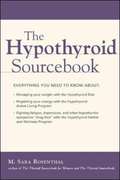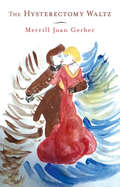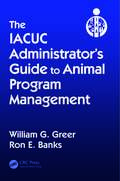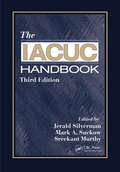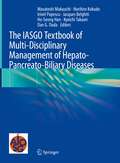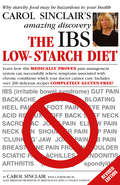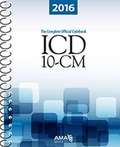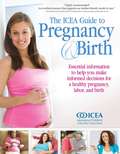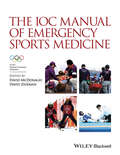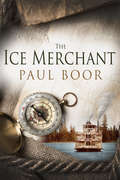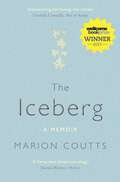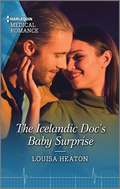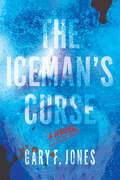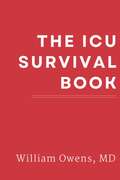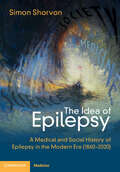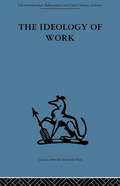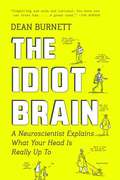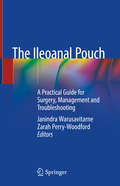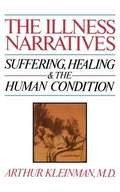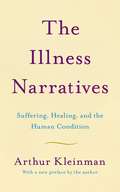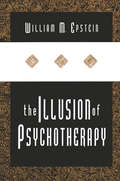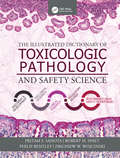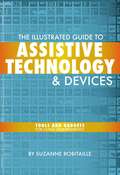- Table View
- List View
The Hypothyroid Sourcebook
by M. Sara RosenthalHypothyroidism is one of the most common forms of thyroid disease. Myriad symptoms are attributed to this disease, including extreme fatigue, depression, headaches, chest pain, constipation, muscle spasms, weight gain, and more. Written by an acclaimed health author afflicted with hypothyroidism, The Hypothyroid Sourcebook offers in-depth explanations of the thyroid and the disease. The book discusses the pros and cons of possible treatments and provides an extensive list of additional resources.
The Hysterectomy Waltz
by Merrill Joan Gerber"It's truly powerful, and acrid, and barbed, and filled with wonderful, and unexpected, turns of phrase and above all it's shocking in its directness and understated anger and sadness and fear... it's an amazing piece of writing."-Cynthia OzickImagine being told before the age of forty that because you have an ovarian cyst, the surgeon wants to take out the "whole kit and caboodle." Imagine being told that "because you already have your children, "who needs all that?" Why not "keep the playground but get rid of the plumbing?" Imagine watching a film strip at the hospital which assures you that though you will no longer have your female organs, you will still have romance in your life and will be "able to waltz the night away with your husband."The Hysterectomy Waltz is a sharp and cynical, funny and tragic comedy, a story of marriage and motherhood under the threat of the knife, a tale of friendship and betrayal.
The IACUC Administrator's Guide to Animal Program Management
by Ron E. Banks William G. GreerThe IACUC Administrator's Guide to Animal Program Management supports IACUC administrators who assist with developing, managing, and overseeing a program of animal care and animal use. It provides many options and possibilities for specific operational practices (e.g., how to build a well-functioning IACUC, what a functional protocol temp
The IACUC Handbook
by Jerald Silverman Mark A. Suckow Sreekant MurthyEver since its establishment by USDA regulation in the mid-1980s, the Institutional Animal Care and Use Committee (IACUC) has evolved as the premier instrument of animal welfare oversight within research institutions in the United States. As biomedical research continuously grows, the role and impact of the IACUC has increased in scope and complexity. The IACUC Handbook has become "the Bible" for individuals when the time comes for them to serve on their institution’s IACUC. It provides a foundation for understanding and implementing the many and varied responsibilities of this committee.This Third Edition comprehensively addresses the significant changes in the pertinent regulatory environment and interpretation of applicable federal laws, regulations, and policies. It provides multiple references and commentary on the new edition of the Guide for the Care and Use of Laboratory Animals, the new AVMA Guidelines for the Euthanasia of Animals: 2013 Edition, and the Office of Laboratory Animal Welfare’s Frequently Asked Questions. The Third Edition also features an updated survey of IACUC practices from institutions around the United States, offering wisdom gained from their experience. In addition, it includes a chapter that provides an international perspective on how animal welfare reviews can function in other countries.
The IASGO Textbook of Multi-Disciplinary Management of Hepato-Pancreato-Biliary Diseases
by Jacques Belghiti Norihiro Kokudo Masatoshi Makuuchi Ho-Seong Han Irinel Popescu Kyoichi Takaori Dan G. DudaThis textbook includes 70 chapters contributed by an exceptional group of experts in all areas of hepato-pancreato-biliary diseases, bringing a multi-disciplinary approach to treatments. The book is designed to cover all aspects of the liver and pancreatic anatomy and pathology, as well as therapy. The topics are comprehensively reviewed, and as well as summarizing the previous works, the authors provide discussions of practice-changing techniques and approaches to therapy of HBP cancers. Treating the diseases in hepato-pancreato-biliary regions is particularly difficult due to the complex anatomy, aggressive biological behavior, and poor prognosis. Therefore, ample illustrations are included to tackle these challenges.The IASGO Textbook of Multi-Disciplinary Management of Hepato-Pancreato-Biliary Diseases aims to update the academic and non-academic medical professionals, such as surgeons, radiation oncologists, medical oncologists, gastroenterologists, interventional radiologists, radiologists, basic scientists. In collaboration with the International Association of Surgeons, Gastroenterologists and Oncologists (IASGO), delivers a valuable and well-organized textbook for medical professionals.
The IBS Low-Starch Diet: Why starchy food may be hazardous to your health
by Carol SinclairTwenty per cent of the UK population - 12 million people - suffer IBS-related symptoms, but they may be unaware that the simple elimination of starch from their diet can bring dramatic relief from pain and discomfort.In this revised edition, Carol Sinclair, a sufferer who has successfully overcome IBS and arthritic pain, brings you a revolutionary programme for a pain-free future. This practical guide will help millions to reduce their arthritic symptoms, whose pain to date has been relieved only by regular medication, with sometimes dangerous side effects.The diet shows that a gradual reduction of starch in one's diet can dramatically reduce pain in days, to a point where drug usage is reduced and, in some cases, eliminated completely. Details of the discovery - along with case histories and a practical guide - make Carol Sinclair's book a first in the world.The IBS Low-Starch Diet also contains over 200 delicious starch- and gluten-free recipes, along with a comprehensive guide to eating out.
The ICD-10-CM: The Complete Official Codebook 2016 Edition
by American Medical AssociationThis codebook provides the complete code set for diagnostic coding. All 21 chapters have been organized to provide quick and simple navigation of the text in order to facilitate accurate diagnostic coding.
The ICEA Guide to Pregnancy & Birth
by International Childbirth Education AssociationEssential information to help you make informed decisions for a healthy pregnancy, labor, and birth. In this new guide, the International Childbirth Education Association (ICEA) presents the best available evidence-based research on pregnancy, childbirth, and newborn care. Its goal is to help expectant parents understand their options in maternity care, and to guide them as they make informed decisions that are best for them and their families. Written in plain English and organized for easy reference, this is a great resource for any childbirth class.
The IOC Manual of Emergency Sports Medicine
by David Mcdonagh David ZidemanThe Manual focuses on the fieldside diagnosis and treatment of severe injuries and illnesses that can present at a sports event. It concentrates on basic diagnostic skills and treatment modalities as the sports physician has often limited diagnostic and treatment facilities available. Each chapter concentrates on an illness or anatomical injury and offers a structured diagnostic and therapeutic approach in this difficult pre-hospital environment. The chapters explain what problems are to be expected with specific conditions as well as which treatment plan should be implemented and how to evaluate and reassess those plans.
The Ice Merchant
by Paul BoorIt's the year 1889, and a shrewd Yankee ice merchant, Nicolas Van Horne, has been carving out a profitable side-business. Deep in his ship's icy hold, dozens of human cadavers lie between the huge blocks of ice. On this delivery, his first to Galveston's new Medical School, Nicolas makes the ghastly discovery that he's been trafficking in murdered boys. Only with the help of Renée Keiller, Galveston's lovely lady scientist, will Nicolas eventually solve the puzzle his ice holds . . . but first he must overcome his personal demon of morphine addiction, and become inextricably entangled in Renée's experiments on the most dreaded killer of the time, Yellow Fever.Paul Boor, M.D., is a scientist and professor at Galveston's medical school, the oldest west of the Mississippi. His first novel, BLOOD NOTES, was a modern biomedical thriller. In THE ICE MERCHANT, Dr. Boor explores the history of the body trade, while plumbing the depths of the human frailties of those devoted to scientific discovery.
The Iceberg: A Memoir
by Marion CouttsIn 2008 the art critic Tom Lubbock was diagnosed with a brain tumor. The tumor was located in the area controlling speech and language, and would eventually rob him of the ability to speak. He died early in 2011. Marion Coutts was his wife. In short bursts of beautiful, textured prose, Coutts describes the 18 months leading up to her partner's death. This book is an account of a family unit, man, woman, young child, under assault, and how the three of them fought to keep it intact. Written with extraordinary narrative force and power, The Iceberg is almost shocking in its rawness. It charts the deterioration of Tom's speech even as it records the developing language of his child. Fury, selfishness, grief, indignity, and impotence are all examined and brought to light. Yet out of this comes a rare story about belonging, an "adventure of being and dying." This book is a celebration of each other, friends, family, art, work, love, and language.
The Icelandic Doc's Baby Surprise: The Icelandic Doc's Baby Surprise / Christmas With Her Lost-and-found Lover (Mills And Boon Medical Ser.)
by Louisa HeatonTheir passionate fling…Has given them a gift to last a lifetime!When pediatrician Merry Bell turns up at his hospital in Iceland, Dr. Kristjan Gunnarsson’s quiet Christmas is shaken up. After a hot fling together in Hawaii, they both agreed to walk away. But now Merry has brought him life-changing news—she’s pregnant! Commitmentphobic Kristjan will not waver from his responsibility, but is his bruised heart ready for a family?From Harlequin Medical: Life and love in the world of modern medicine.
The Iceman's Curse
by Gary F. JonesNature, climate, and stupidity produce a pandemic.Grant Farnsworth, a post-doc student, veterinarian, and virologist at the University of Minnesota is upset when his professor tells him to prepare to work on tissue samples from a 1,200-year-old corpse called the Iceman, that was found in the Swiss Alps. Grant is already working seven days a week and his wife is eight months pregnant with their second child. The situation becomes more complicated when a Swiss professor, to avoid regulations, smuggles the samples into the United States, putting Grant and his professor in legal jeopardy.When a blizzard diverts the professor's flight to Chicago, Customs is hectic, and the professor mistakenly swaps his suitcase with Frank, a drug mule. When Frank discovers the mistake he and a friend follow the professor north on I-94 with the intention to do whatever is necessary to recover the missing drugs. When snow forces the professor to stop at a motel in the hamlet of Kirby, Wisconsin, he has no idea that he's carrying drugs and that his life is in jeopardy.When Switzerland announces that those who handled Iceman samples are ill, and several have died, Grant is sent to Kirby to find the Swiss professor and isolate the samples. At the same time, the CDC learns of the samples in Kirby and dispatches Dr. Sybil Erypet to Fort McCoy, a nearby Army base, to get the samples under control.Between dangerous drug mules and infected tissue samples, many lives in the snow-bound village are in jeopardy.
The Icu Survival Book
by William Owens Lorien OwensThe ICU Survival Book is a guide for residents, students, advanced practice providers, and critical care nurses who want to learn the basics of critical care medicine. This reference is designed to follow the systems-based format that is used during rounds in the intensive care unit. Hemodynamics, respiratory failure, neurocritical care, and massive transfusion protocols are among the topics covered. The ICU Survival Book is not a comprehensive textbook on critical care. It is designed to be a tool to be used at the bedside, between patients, and in the workroom. Each section has a list of things you'll be expected to know on rounds, along with the key concepts you must understand to survive your ICU rotation. The ICU Survival Book is the latest publication from the author of the internationally bestselling The Ventilator Book. Dr. William Owens is known for explaining complex medical subjects in terms that are easy for learners to understand. This book is perfect for trainees, students on clinical rotations, and unit staff.
The Idea of Epilepsy: A Medical and Social History of Epilepsy in the Modern Era (1860–2020)
by Simon D. ShorvonEpilepsy has a fascinating history. To the medical historian Oswei Temkin it was 'the paradigm of the suffering of both body and soul in disease'. It is justifiably considered a window on brain function. And yet its story is more than simply a medical narrative, but one influenced also by scientific, societal and personal themes. Written for a medical and non-medical readership, this book describes the major developments in epilepsy between 1860–2020, a turbulent era in which science dominated as an explanatory model, medical theories and practices steered an erratic course, and societal attitudes and approaches to epilepsy fluctuated dramatically. In the middle of this maelstrom was the person with epilepsy at the mercy of social attitudes and legislation, and at times harmed as well as helped by medicine and science. So entangled is the history that intriguingly, as an entity, epilepsy may now be thought not even to exist.
The Ideal of Nature: Debates about Biotechnology and the Environment
by Gregory E. KaebnickGoing back at least to the writings of John Stuart Mill and Jean-Jacques Rousseau, people have argued for and against maintaining a state of nature. Is there an inherent virtue in leaving alone a naturally occurring condition, or does the human species thrive when we find ways to improve our circumstances? This volume probes whether "nature" and "the natural" are capable of guiding moral deliberations in policy making.Drawing on philosophy, religion, and political science, this book examines three questions central to debates over the idea of "nature" in human action. Conceptually, it asks what the term means, how it should be considered, and if it is, even in part, a social construct. From a moral perspective, the contributors question if being "natural" is itself of value or if its worth is only as a means to advance other morally acceptable ends. Politically, essays discuss whether appeals to nature can and should affect public policy and, if so, whether they are moral trump cards or should instead be fitted alongside or weighed against other concerns. Achieving consensus on these questions has proven elusive and seems unattainable. This should not, however, be an obstacle to moving the debate forward. By bringing together disparate approaches to addressing these concepts, The Ideal of Nature suggests the possibility of intermediate positions that move beyond the usual full-throated defense and blanket dismissal found in much of the debate. Scholars of bioethics, environmental philosophy, religious studies, sociology, public policy, and political theory will find much merit in this book’s lively discussion.
The Ideology of Work (International Behavioural And Social Sciences Ser. #Vol. 71)
by P D AnthonyTavistock Press was established as a co-operative venture between the Tavistock Institute and Routledge & Kegan Paul (RKP) in the 1950s to produce a series of major contributions across the social sciences. This volume is part of a 2001 reissue of a selection of those important works which have since gone out of print, or are difficult to locate. Published by Routledge, 112 volumes in total are being brought together under the name The International Behavioural and Social Sciences Library: Classics from the Tavistock Press. Reproduced here in facsimile, this volume was originally published in 1972 and is available individually. The collection is also available in a number of themed mini-sets of between 5 and 13 volumes, or as a complete collection.
The Idiot Brain: A Neuroscientist Explains What Your Head Is Really Up To
by Dean BurnettThe brain may be the seat of consciousness and the engine of all human experience, but it’s also messy, fallible and disorganized. It’s undeniably impressive, but it’s far from perfect, and these imperfections influence everything that humans say, do and experience. In The Idiot Brain, Dean Burnett celebrates the downright laughable things our minds do to us, as well as exposing the fact that people are often way off in their thinking about how the brain works. For example, did you know thatyour memory is egotistical?stress can actually increase your performance at a task?conspiracy theories and superstitions stem from your brain’s insistence that the world isn’t random?the brain’s limitations mean you really can miss something that’s right under your nose?the way the brain’s processing works means that time really does fly if you’re having fun?alcohol can sometimes improve your memory?Dean Burnett’s unpredictable and entertaining first book explores the unexpected side of everyday life, highlighting where conventional thinking is wrong and how our brains trip us up at every turn. This is lucid, funny and smart: in short, the best kind of popular science.
The Ileoanal Pouch: A Practical Guide for Surgery, Management and Troubleshooting
by Janindra Warusavitarne Zarah Perry-WoodfordThis book gives a comprehensive overview of surgery that results in creating an ileoanal pouch or continent ileostomy. It deals with the entire journey of pouch surgery starting from patient selection and counselling to technical tips and tricks and ending in managing pouch function and failure. Containing a patient experience section this volume helps clinicians better understand what a patient expects from the ileoanal pouch.This is a very specialised topic but one that is covered very poorly and this book has the potential to consolidate all that is known about the topic to provide a comprehensive overview on the surgery and its consequences.
The Illegal Wildlife Trade in China: Understanding The Distribution Networks (Palgrave Studies in Green Criminology)
by Rebecca W. WongThis book offers a theoretically-based study on crimes against protected wildlife in mainland China with first-hand empirical data collected over five years. It provides an overall examination of crimes against protected and endangered wildlife and an extensive account of the situation in China, where a significant portion of the illegal wildlife trade is currently happening. This emerging field has become an important topic for enforcement and governments alike yet remains an under-researched area. The collected data covers illegal tiger-parts trade, the illegal ivory trade, and the consumption of protected wildlife. The book will serve as a useful reference for scholars, law-enforcement agencies, lawyers, and conservation and wildlife-protection NGO groups to facilitate their understanding of the growing illegal trade in protected and endangered wildlife. The Illegal Wildlife Trade in China has three general aims: first, to contribute to the general development of green criminology and specifically to the literature of the illegal transactions of protected wildlife at the distribution stage. Second, it aims to understand how illegal transactions are carried out to create insights for policy makers and law enforcement professionals. Finally, Wong seeks to apply theoretical frameworks (such as that of trust, networks, and situational crime prevention) to the understanding of the distribution of illegal wildlife products in order to make contributions to ongoing sociological and criminological discussions.
The Illness Narratives: Suffering, Healing, And The Human Condition
by Arthur KleinmanA Harvard psychiatrist and anthropologist argues that interpreting the illness experience is an art tragically neglected by modern medical training, and presents a compelling case for bridging the gap between patient and doctor. Based on twenty years of clinical experience studying and treating chronic illness, a Harvard psychiatrist and anthropologist argues that diagnosing illness is an art tragically neglected by modern medical training, and presents a compelling case for bridging the gap between patient and doctor.
The Illness Narratives: Suffering, Healing, And The Human Condition
by Arthur KleinmanFrom one of America's most celebrated psychiatrists, the book that has taught generations of healers why healing the sick is about more than just diagnosing their illness.Modern medicine treats sick patients like broken machines -- figure out what is physically wrong, fix it, and send the patient on their way. But humans are not machines. When we are ill, we experience our illness: we become scared, distressed, tired, weary. Our illnesses are not just biological conditions, but human ones. It was Arthur Kleinman, a Harvard psychiatrist and anthropologist, who saw this truth when most of his fellow doctors did not. Based on decades of clinical experience studying and treating chronic illness, The Illness Narratives makes a case for interpreting the illness experience of patients as a core feature of doctoring.Before Being Mortal, there was The Illness Narratives. It remains today a prescient and passionate case for bridging the gap between patient and practitioner.
The Illusion of Psychotherapy
by William EpsteinIn The Illusion of Psychotherapy William Epstein asserts that psychotherapy is probably ineffective and possibly harmful. He maintains that there is no credible clinical evidence that psychotherapy is effective in handling personal or social problems, or that it is more effective than other modes of treatment. The theories that underpin clinical practice remain speculative and their influence over social policy are more ideological than scientific. A skeptical public and its government would be better served, Epstein says, by credible evidence of outcomes. His analysis focuses on whether psychotherapy is effective against a variety of unwanted behaviors, such as drug addiction and depression.The nation's social problems are due to the inadequacies of its core social institutions: families, communities, education, and jobs. Social problems emerge because many people are brought up in deficient families, live in dangerous communities, lack education and jobs, and have few or no routes out of poverty. Poor people are exposed to unrelenting risks to their physical and mental health. It is possible to remedy most deficiencies through human services that compensate for these failed social institutions.This position is inevitably unpopular in psychotherapeutic circles and in light of current political preferences since it requires massive new resources and extensive redistribution of existing resources. The extent of society's problems reflects the degree to which deficits in basic social institutions have been tolerated. Basic services have been lacking while psychotherapy diverts our impulse to address poverty into ineffective strategies. In a challenging conclusion, Epstein urges society to solve its problems by confronting the reality implied by the failure of psy-chotherapy's minhnal interventions: to acknowledge that more is necessary to resolve social need. This leads to general theoretical concerns about theory as such. The Illusion of Psychotherapy will be compelling reading for psychologists, psychotherapists, social scientists, and policymakers.
The Illustrated Dictionary of Toxicologic Pathology and Safety Science
by Pritam S. Sahota, Robert H. Spaet, Philip Bentley and Zbigniew W. WojcinskiThere has been a growing interest in toxicologic pathology, especially as related to its impact on the safety assessment of pharmaceuticals and chemicals, and in drug development. Thus, there is a growing need for an Illustrated Dictionary of Toxicology Pathology and Safety Science (IDTP) that this dictionary aims to fill. The language of toxicologic pathology may be less familiar to a broad range of safety scientists, especially those involved in the safety evaluation of pharmaceuticals and chemicals. The IDTP format provides the brevity and clarity that the user is not likely to receive in a textbook, even if adequately indexed. With the inclusion of descriptions for terms used in toxicology, drug metabolism/pharmacokinetics, and regulatory science, the scope of the IDTP is considerably broadened and decidedly unique in its appeal to all safety scientists. With over 800 photos and illustrations to provide visual context,* an important aim of the IDTP is to present pathological changes as reference examples for terminology, nomenclature, and term descriptions for the entry entry-level as well as seasoned toxicologic pathologist. It will also aid students and non-pathology specialists such as study directors, senior toxicology report reviewers, scientific management of contract research organizations, regulatory agencies, and drug development companies to better understand the biological significance of tissue changes. The IDTP provides a single reference volume for these users to further their understanding and appreciation of biologically significant pathology findings. The IDTP consists of four major areas: 1. A-Z Dictionary of Pathology encompassing all organ systems, together with relevant non-pathology terms supported by references in "For Further Reading" sections. 2. Appendix 1: An Overviews of Drug Development, Nonclinical Safety & Toxicologic Pathology, and Important/Special Topics. 3. Appendix 2: Diagnostic Criteria of for Proliferative Proliferative Lesions in Rodents (Rat and Mouse) and Selected Non-Rodent Laboratory Species containing illustrations with detailed references and links to source material. 4) Appendix 3: Mini-Atlas of Organ System Anatomy and Histology to help re-acquaint the non-pathologist safety scientist with many normal anatomical structures. The editors and contributing scientists (board-certified veterinary pathologists, board-certified toxicologists, allied health safety scientists, health regulatory representatives) have experience from bench-level pathology and toxicology to managing global preclinical safety units in leading pharmaceutical companies. They have considerable experience mentoring pharmaceutical industry project team members, interacting with industry clinicians and representatives of decision-making bodies within the industry, as well as with global health authorities, such as the FDA and EMA. These activities convinced them of the necessity for and usefulness of the IDTP. As experts in their field, they have undertaken the hard work of writing and compiling the information, making the IDTP an exceptional, go-to reference. *Illustrations Editor: Gregory Argentieri
The Illustrated Guide to Assistive Technology and Devices: Tools and Gadgets for Living Independently
by Suzanne Robitaille"A Doody's Core Title 2012"This new illustrated guide to assistive technologies and devices chronicles the use of AT/AD - technology used by individuals with disabilities to perform functions that might otherwise be difficult or impossible. This book empowers people to use assistive technologies to overcome some of their physical or mental limitations and have a more equal playing field. It includes real-life examples about how people with disabilities are using assistive technology (AT) to assist them in daily tasks, and discusses emotional issues related to AT/AD.
